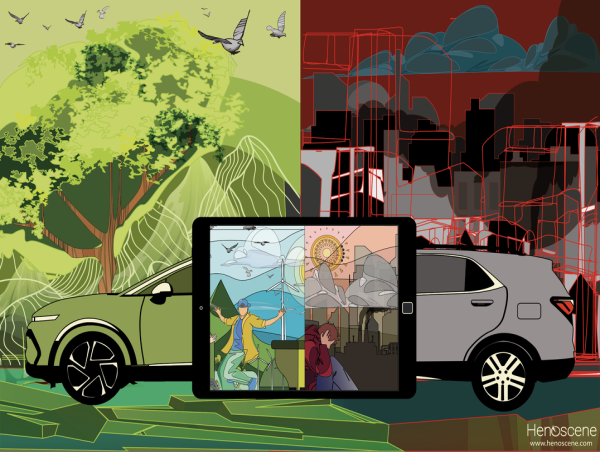SEATTLE, WA, UNITED STATES, October 10, 2024 /EINPresswire.com/ -- On August 29th 2024, at the Wild 12 Congress, which gathered world leaders and indigenous communities, entrepreneur and explorer Asher Jay unveiled the six Ps of the Ecodynamic Business Model, which offers a holistic, ecologically grounded framework that ushers organisations into an integrated, resilient, and authentically sustainable future. Today's marketing landscape is shifting at a seismic scale. Traditional paradigms like the Four 'P's of marketing—product, price, place, and promotion—are quickly becoming relics of the past. Similarly, broad commitments to sustainable development encapsulated in the five pillars of SDGs—People, Planet, Prosperity, Peace, and Partnerships—often yield fragmented efforts that fall short of genuine transformation.
In contrast, the Six 'P's are intrinsically holistic:
1. Presence: Nature thrives in the present, constantly alert and interactive. Similarly, brands should be profoundly aware and engaged with their stakeholders, fostering genuine connections rather than relying on superficial marketing ploys. Brands can assimilate such coherence and effectiveness by restructuring themselves to empower them to be more present. By building lean interdisciplinary niches of layered expertise within its larger, more slow-moving umbrella, it can still retain a nimble, adaptive, and accessible approach to global and regional realities.
2. Process: Nature's lifecycle, involving growth, decay, and renewal, is the ideal model for sustainable business practices. "Process" ensures nothing gets wasted, that remainders are self-contained, inert, or accounted for, and everything loops back on itself. Not only would this save a brand a tremendous number of costs, but it would prove inherently sustainable to our Earth as it would behave the way everything else in the universe and on this planet behaves.
3. Participate: In nature, everything is interconnected, continuously engaging in symbiotic relationships. Brands should likewise foster dynamic, inclusive collaboration. Brands can opt for materials that simulate nature's membranes and strive to reach balance in every process within its organizational structure. Brands can enrich, educate, enlist, and embolden their customers, employees, and communities; they can explore waste repurposing, composting, and disintegration into valuable constituents. Brands can be feedback-driven during every stage of the Eco-Dynamic Process, ensuring equitable access to innovation, reciprocity in stakeholder relationships, and shared beneficial outcomes
4. Populate: Nature's diversity is its strength, and brands need to adopt this richness by diversifying their offerings and ensuring they can be reused or repurposed at the end of their lifecycle. Brands have yet to approach populating the world with their products, services, and experiences as holistically as nature does. Brands also fail to develop products in packaging capable of delivering more than one use case or alleviating more than one pain point throughout its life span to either the same or two different customer segments.
5. Purge: Nature has an organic cycle of renewal and purification through processes like disease, death, destruction, degeneration, and decomposition. Brands tend to view these words as negatives instead of leveraging these processes to bolster resiliency in their products, practices, methods, messaging, and deliverables. Proactively placing hard limits or instituting checks and balances, termination triggers, and accounting for deterioration in a brand's life cycle makes it hardy and flexible.
6. Pause: Nature typically takes a pause or goes into rest and recovery cycles based on season, phase of the lifecycle, or time of day. These break periods allow plants and animals to conserve energy, rejuvenate, and prepare for the upcoming seasons, stages of life, or times of day. Similarly, processes take respite or attain entropy states before they cascade into chaos due to external variations. This allows for the optimisation of resources and energy expended toward the movement and momentum of nutrients and materials within a system. Brands must take their feet entirely off the "profit-margin" and "shareholder-returns" pedals at different moments to enhance ecological regeneration and social revitalization.
Why Embrace the Ecodynamic Model?
1. Authenticity Over Allure: Trust has become the cornerstone of modern marketing, increasingly prioritized over traditional sales tactics. This trust is built through genuine engagement and applicable solutions rather than hollow promotional campaigns and symptom alleviation. The Eco-Dynamic Model delivers necessary real-world change within bureaucratic institutions, which will resonate deeply with today’s conscientious consumers.
2. Resilience and Adaptation: Businesses inherently become more adaptive and resilient by mirroring nature's processes. They can better navigate market volatility and environmental uncertainties, ensuring longevity. The success of brands like **Patagonia** and **Tesla** demonstrates the viability of this approach.
3. Systemic Integration: Traditional models often isolate business functions. The Ecodynamic Model calls for a system-wide integration that considers the full lifecycle of products, social impacts, and ecological footprint. This model makes sustainability not an auxiliary effort but a core business strategy.
4. Holistic Impact: Embracing the Ecodynamic Model allows brands to transcend piecemeal sustainability efforts and approach every facet of their business with an integrated perspective. This is not just about reducing carbon footprints but about reimagining business operations, supply chains, and stakeholder engagement to maximize positive impact. Brave brands, already pioneers in this area, can continue demonstrating how holistic integration can lead to radical transformation and measurable environmental benefits.
5. Innovation and Growth: The Eco-Dynamic Model propels brands towards innovation by challenging them to think outside conventional paradigms. Leveraging nature-inspired and regenerative principles fosters creativity and drives the development of new products, services, and business models. By adopting these principles, companies that have already started their sustainability journey can continue to lead their industries, not just through their products but also through their innovative and sustainable approaches to growth.
6. Consumer Alignment: Today's consumers are more informed and demand transparency and accountability from the brands they support. The Ecodynamic Model aligns with the values of modern consumers, who prioritize ethical, environmentally friendly, and socially responsible products. This alignment strengthens brand loyalty and expands market share among an increasingly conscientious consumer base.
Congress attendees discerned the urgent need to adapt to sustainable practices that proactively move beyond the conventional paradigm. Climate change, resource scarcity, and social inequities present significant challenges that the traditional business-as-usual approach cannot solve. The Ecodynamic Model provides a forward-thinking, comprehensive framework that enables companies to thrive while contributing positively to the world.
Asher Jay
Henoscene
+1 917-769-7925
email us here
Visit us on social media:
Facebook
X
LinkedIn
Instagram
YouTube
TikTok
Legal Disclaimer:
EIN Presswire provides this news content "as is" without warranty of any kind. We do not accept any responsibility or liability for the accuracy, content, images, videos, licenses, completeness, legality, or reliability of the information contained in this article. If you have any complaints or copyright issues related to this article, kindly contact the author above.
![]()




